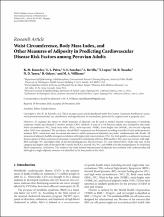Mostrar el registro sencillo del ítem
Waist circumference, body mass index, and other measures of adiposity in predicting cardiovascular disease risk factors among Peruvian adults
| dc.contributor.author | Knowles, K. M. | |
| dc.contributor.author | Paiva, L. L. | |
| dc.contributor.author | Sanchez, S. E. | |
| dc.contributor.author | Revilla, L. | |
| dc.contributor.author | Lopez, T. | |
| dc.contributor.author | Yasuda, M. B. | |
| dc.contributor.author | Yanez, N. D. | |
| dc.contributor.author | Gelaye, B. | |
| dc.contributor.author | Williams, M. A. | |
| dc.date.accessioned | 2020-07-17T15:54:16Z | |
| dc.date.available | 2020-07-17T15:54:16Z | |
| dc.date.issued | 2011 | |
| dc.identifier.citation | Knowles KM., Paiva LL., Sanchez SE., Revilla L., Lopez T., Yasuda MB., et al. Waist circumference, body mass index, and other measures of adiposity in predicting cardiovascular disease risk factors among Peruvian adults. Int J Hypertens. 2011; 2011: 931402 | es_PE |
| dc.identifier.uri | https://hdl.handle.net/20.500.12727/6358 | |
| dc.description.abstract | Objectives. To examine the extent to which measures of adiposity can be used to predict selected components of metabolic syndrome (MetS) and elevated C-reactive protein (CRP). Methods. A total of 1,518 Peruvian adults were included in this study. Waist circumference (WC), body mass index (BMI), waist-hip ratio (WHR), waist-height ratio (WHtR), and visceral adiposity index (VAI) were examined. The prevalence of each MetS component was determined according to tertiles of each anthropometric measure. ROC curves were used to evaluate the extent to which measures of adiposity can predict cardiovascular risk. Results. All measures of adiposity had the strongest correlation with triglyceride concentrations (TG). For both genders, as adiposity increased, the prevalence of Mets components increased. Compared to individuals with low-BMI and low-WC, men and women with high-BMI and high- WC had higher odds of elevated fasting glucose, blood pressure, TG, and reduced HDL, while only men in this category had higher odds of elevated CRP. Overall, the ROCs showed VAI, WC, and WHtR to be the best predictors for individual MetS components. Conclusions. The results of our study showed that measures of adiposity are correlated with cardiovascular risk although no single adiposity measure was identified as the best predictor for MetS. | es_PE |
| dc.description.sponsorship | Dirección General de Dirección de Epidemiología (Dirección Nacional de Epidemiología) y el Instituto Nacional de Salud del Perú, Lima, Perú. Premio de los Institutos Nacionales de Salud, Nacional Centro de Salud de las Minorías y Disparidades de Salud (no. T37-MD001449). | es_PE |
| dc.format.extent | 10 p. | es_PE |
| dc.language.iso | eng | es_PE |
| dc.publisher | Hindawi | es_PE |
| dc.relation.ispartof | urn:issn:0165-0327 | |
| dc.relation.ispartofseries | International Journal of Hypertension;vol. 2011 | |
| dc.relation.uri | https://doi.org/10.4061/2011/931402 | es_PE |
| dc.rights | info:eu-repo/semantics/openAccess | es_PE |
| dc.rights.uri | https://creativecommons.org/licenses/by/4.0/ | es_PE |
| dc.source | Repositorio Académico USMP | es_PE |
| dc.source | Universidad San Martín de Porres - USMP | es_PE |
| dc.subject | Circunferencia de la cintura | es_PE |
| dc.subject | Índice de masa corporal | es_PE |
| dc.subject | Adiposidad | es_PE |
| dc.subject | Factores de riesgo | es_PE |
| dc.subject | Enfermedades cardiovasculares | es_PE |
| dc.subject | Adulto | es_PE |
| dc.subject | Perú | es_PE |
| dc.title | Waist circumference, body mass index, and other measures of adiposity in predicting cardiovascular disease risk factors among Peruvian adults | es_PE |
| dc.type | info:eu-repo/semantics/article | es_PE |
| thesis.degree.name | Medicina Humana | es_PE |
| thesis.degree.grantor | Universidad de San Martín de Porres. Facultad de Medicina Humana | es_PE |
| thesis.degree.discipline | Medicina | es_PE |
| dc.publisher.country | GB | es_PE |
| dc.subject.ocde | https://purl.org/pe-repo/ocde/ford#3.02.00 | es_PE |
Ficheros en el ítem
Este ítem aparece en la(s) siguiente(s) colección(es)
-
Artículos [274]








